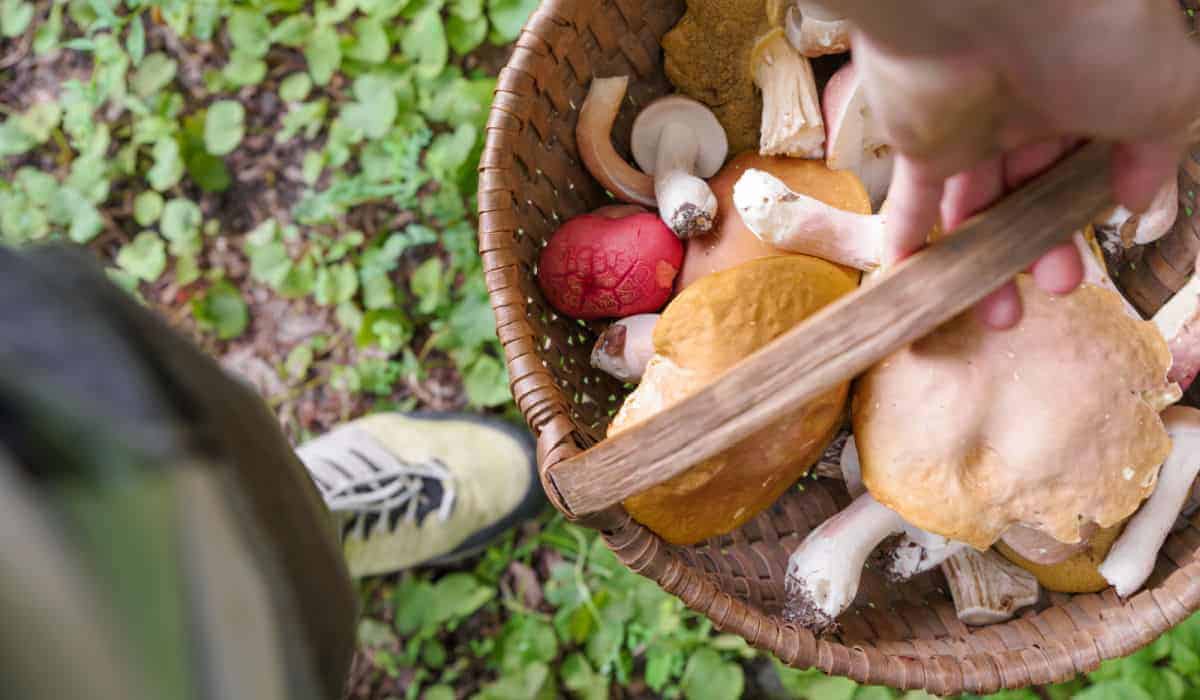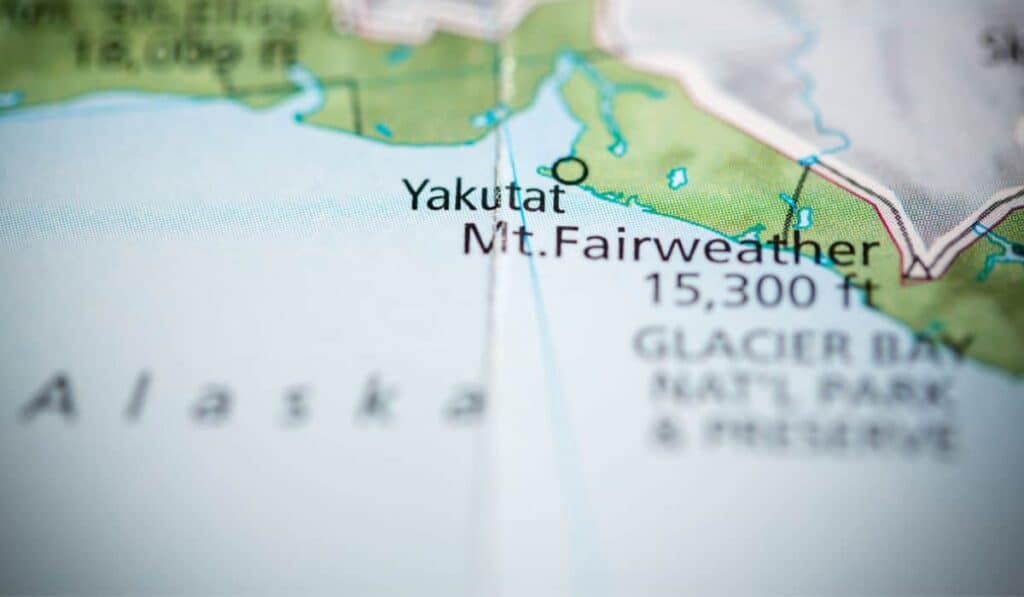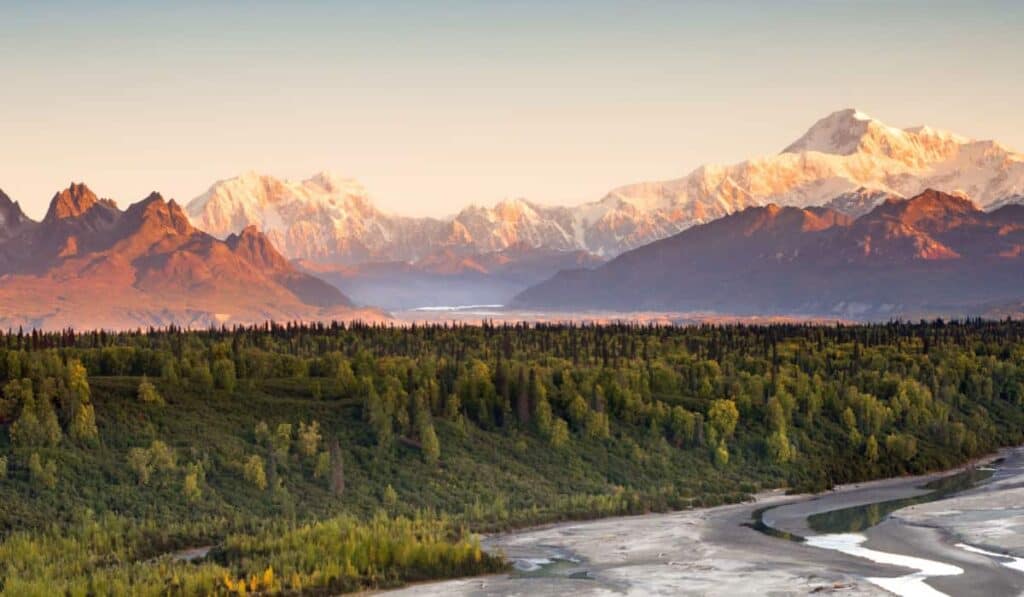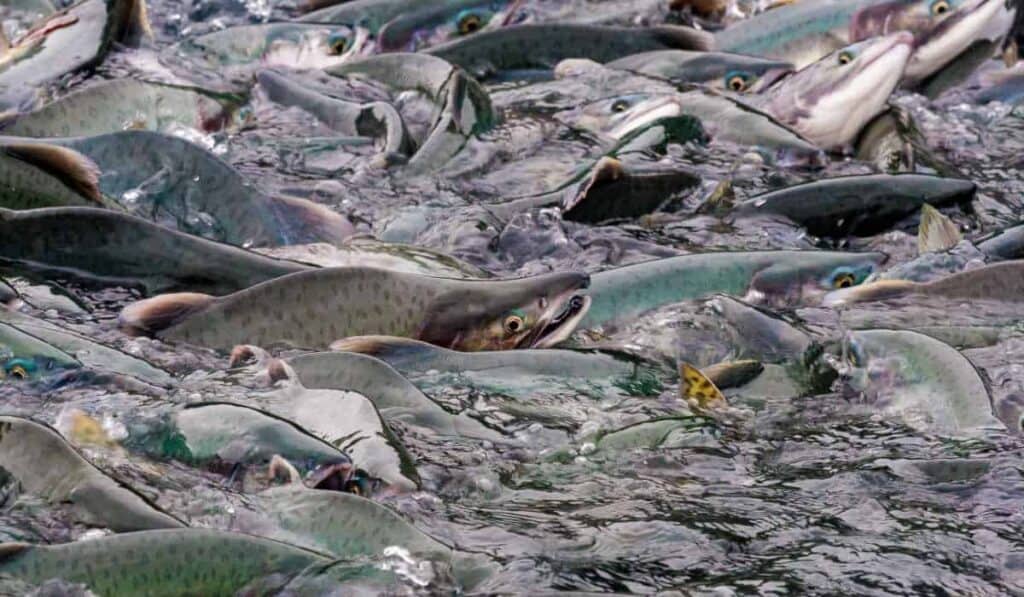Most people seem to have a perception of Alaska as a land full of penguins and people eating whale fat.
Well, surprise, we don’t have penguins in Alaska and most of us aren’t even allowed to eat whales.
What’s more, Alaska is one of the most diverse and rich ecosystems in the entire Western Hemisphere. Alaska has supported millions of people for the past ten thousand years, many of them families on a subsistence lifestyle.
The incredible richness of Alaska’s ecosystem allows for those who wish to do so to harvest huge amounts of wild plants to eat.
For many in Alaska, foraging is tied directly to survival. For the rest of us, it’s simply a fun way to get out of the city, spend some time hiking around, and possibly save some money.
If we’re talking about foraging for mushrooms (as we are in this case) then the saving money piece is a big deal.
Edible mushrooms (and other fresh produce) can be incredibly expensive in Alaska as most of them have to be brought up from Seattle.
Which seems silly when we have such incredible natural resources at our doorsteps.
So, if you’re interested in foraging for edible mushrooms in Alaska, we’ll help you get started!
Alaska is packed full of all types of edible plants but mushrooms are among the most filling and probably the most easily recognized as “food” by non-foragers.
We’ll be focusing mainly on southeast Alaska as it’s the richest area (foraging-wise) in Alaska. Not to mention that it’s where I live.
The Tongass National Forest in southeast Alaska provides the rain and temperate climate necessary for mushrooms to naturally thrive in the forests and meadows.
However, many of these will also be found in other parts of Alaska, the United States, and even Europe.
So break out a foraging basket and let’s get to it!
Alaska’s Edible Mushrooms
Before giving you a list, I have two final warnings.
The first is the one you probably already expect: safety first! Foraging for and eating wild mushrooms can be extremely dangerous if you’re careful. Many poisonous plants will give you sweats and a tummy ache but mushrooms can kill you. In addition to dozens of edible mushroom varieties, Alaska is also home to Deathcaps and other poisonous fungi that you should learn to recognize and avoid.
The second piece of general advice is: just because something is edible doesn’t mean that it tastes good.
If you’ve only ever purchased mushrooms from the grocery store you’ve likely been limited to a couple of varieties that are considered generally palatable. Wild mushrooms can vary widely in taste and some are better than others.
I’ve included types that I enjoy but the only way to find out if they’re enjoyable for you is to forage them and give them a try!
So let’s talk about what you’ll be looking for!
1. King Bolete (Boletus edulis)
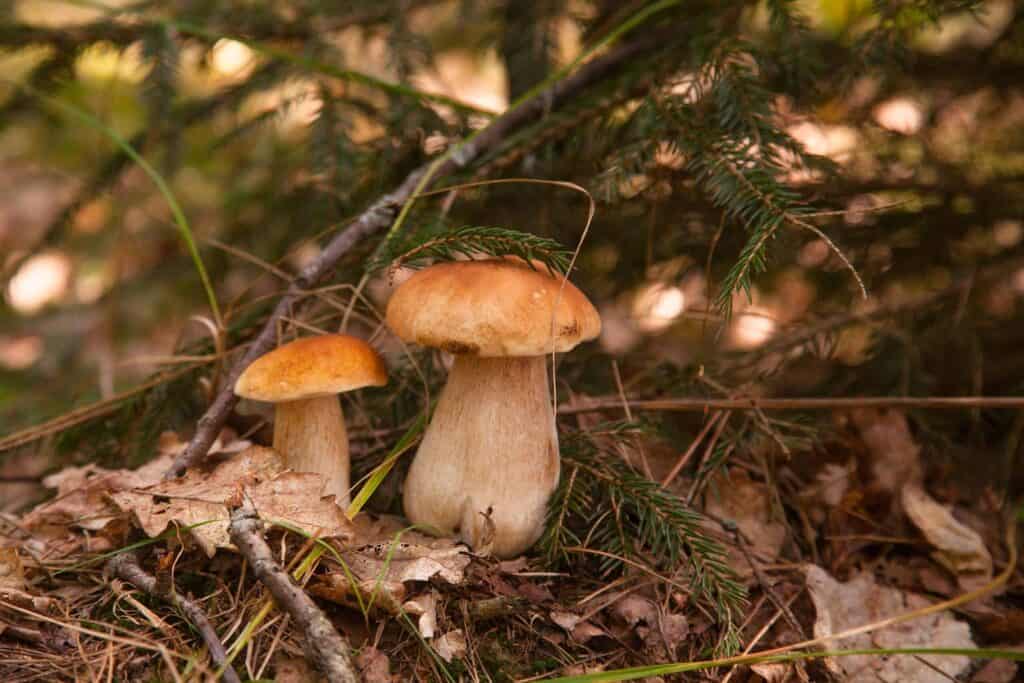

The King Bolete is one of the most prized foraging mushrooms because it is typically easy to find enough for a meal. At times, this means a single mushroom as each specimen can weigh up to 2 lbs!

If you haven’t heard of a King Bolete before it’s possible you know them by their other name: Penny Buns. If you’re new to foraging for mushrooms in Alaska then this a great place to start!
Commercially these fungi are often used in sauces or as a meat substitute (think Portabella). Just be sure to cook them thoroughly before eating—penny buns can be tough if not cooked properly.
2. Alaskan Gold (Phaeolepiota aurea)
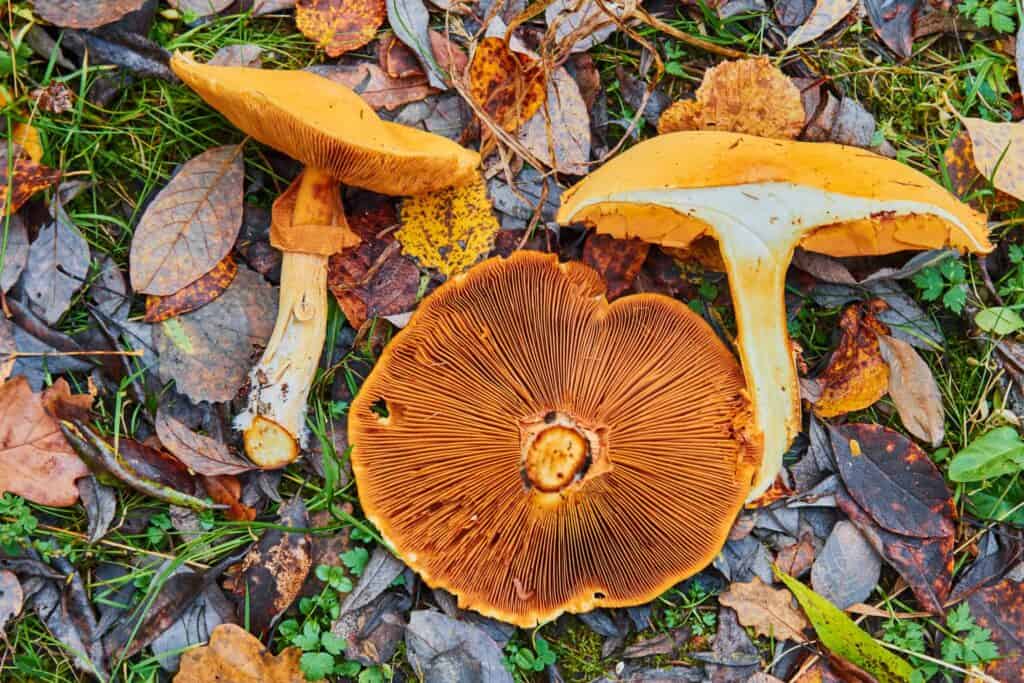
Did you know there’s gold in Alaska? Of course you did, that’s probably what we’re most famous for. However, I’m talking here about a different kind of gold. Edible gold.
While most people associate mushrooms with dark, dank forests, the wide open state of Alaska is home to some of the most delicious specimens that you can forage…such as our subject here.
Phaeolepiota aurea is a yellow- or golden-tinged mushroom that typically grows on decaying logs or tree stumps. While its appearance may not be particularly appetizing, this mushroom is prized for its flavor, which has been described as subtly sweet and slightly nutty. In addition to being eaten fresh, Alaskan gold mushrooms can also be pickled, dried, or made into tea.
The easiest way to recognize this fungi while out in the woods is the obvious color. Beyond that, the stalk is thin and brittle, and the gills are close together.
Bring this one home and your next potluck dish will likely be the talk of the town!
3. Shrimp russula (Russula xerampelina)
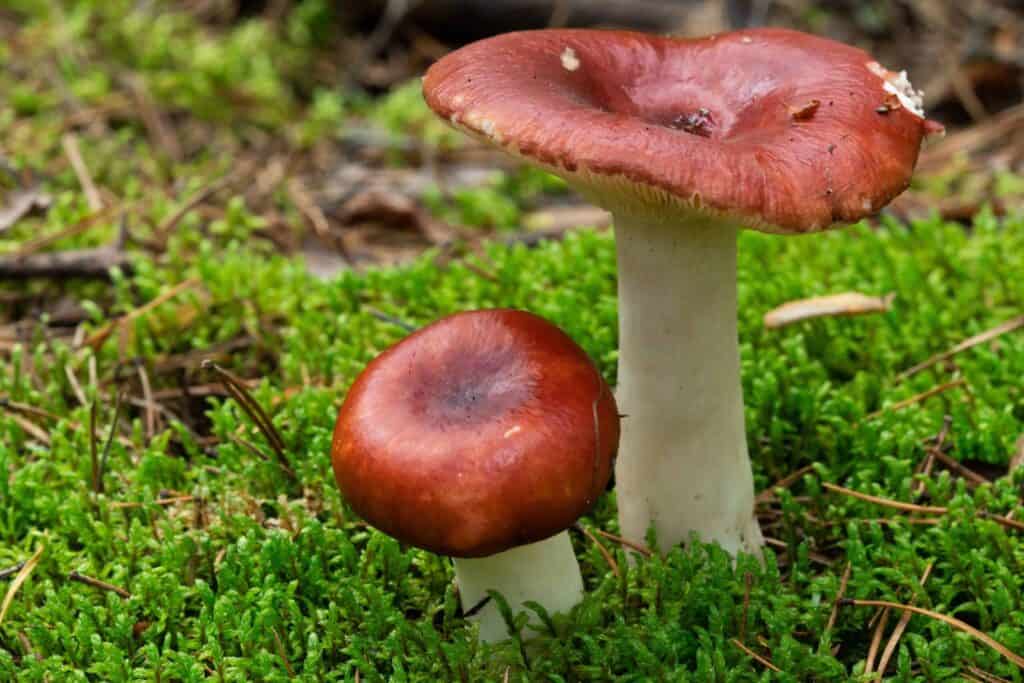
| Identifying Features | Cap: 4-30 cm wide, colors vary from reds, purples to browns, olives. Gills: White to creamy, becoming yellowish with age, often bruising yellowish brown. Stem: 3-12 cm long, 1-4 cm thick, white or flushed with reddish to purplish shades. Flesh: White, discolors to yellowish brown or brown when sliced. |
| Season | The main season for Shrimp Russula in Alaska is from May to November. |
| Taste | Fishlike or shrimplike odor, especially with age; mild taste. |
| Habitat | Shrimp Russula is mycorrhizal with conifers or hardwoods. It is commonly found under conifers, especially Douglas fir, in forest soils. |
| Rarity | This species is widely distributed in North America and is considered common. |
The shrimp russula (Russula xerampelina) is an edible mushroom that can be found in much of Alaska. This mushroom gets its name from its pinkish-orange color and shrimp-like taste.
The shrimp russula is a member of the Russulaceae family, which contains around 500 different species of mushrooms. However, most species in this family are poisonous and the shrimp russula is one of the few that is safe to eat. The family of mushrooms includes notable names such as Russula emetica (which sounds like puke…) and the even more poisonous Russula nobilis.
To identify a shrimp russula, look for a mushroom with a smooth, orange cap and white gills. Just be sure to carry a field guide that mentions its poisonous cousins so that you can cross reference.
While some people claim that these are edible raw I recommend that you cook any mushroom that you intend to eat. When cooked, they can be used in soups, stews, or stir-fries.
This is one of those mushrooms that is hit or miss when it comes to flavor but I find it unique and delicious.
4. Pacific Gold Chanterelle (Cantharellus formosus)

Pacific gold chanterelle are of the most sought-after edible mushrooms found in Alaska.
These mushrooms have a yellow-orange cap and a white stem and grow in moist, shady areas. Pacific gold chanterelles are considered a delicacy by many mushroom lovers and are also a good source of vitamins and minerals, making them a healthy addition to any diet.
If you’re lucky enough to find Pacific gold chanterelles in the wild, be sure to take care when picking them so as not to damage the delicate fungi.
5. Orange Milk-Cap (Lactarius deliciosus group)

This fungus is part of the Lactarius deliciosus group, many of which are prized for their edible qualities.
The orange milk cap typically grows in coniferous forests and can be found from mid-summer to early autumn. This mushroom gets its name from its distinct orange color, which is often a striking contrast to the green of the forest floor.
While the orange milk cap is safe to eat, it is important to properly identify this mushroom before consuming it, as some members of the Lactarius deliciosus group are poisonous. With a little practice, however, it is easy to tell the difference between this edible fungus and its inedible cousins.
6. Gray Fire Morel (Morchella tomentosa)
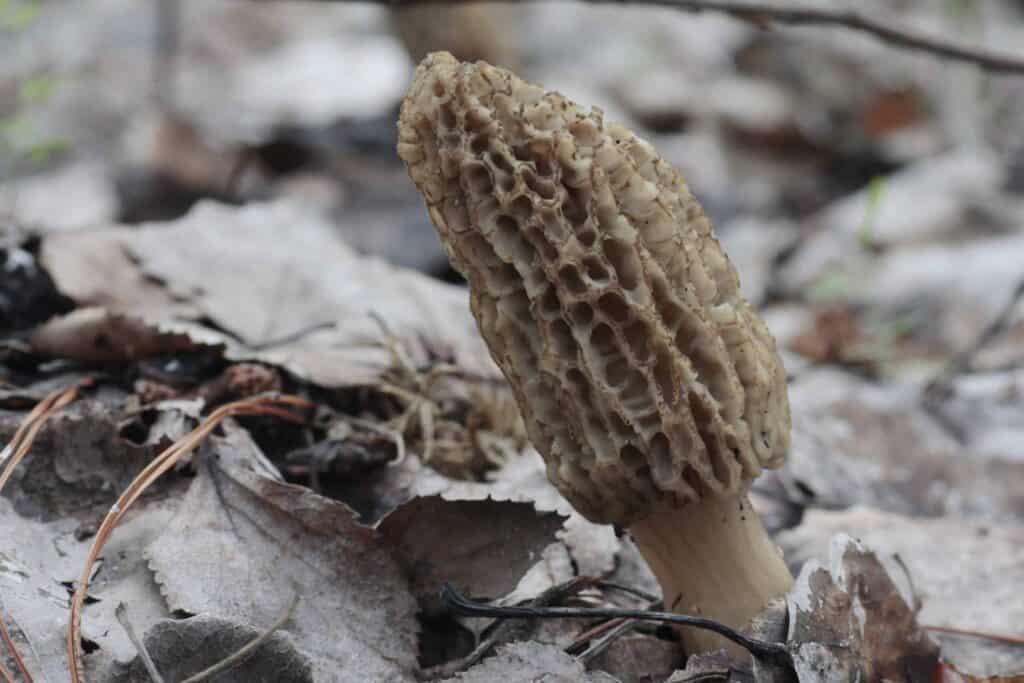
In Alaska, we’re lucky to have a huge variety of morels that can be found in the wild.
One of the most sought-after varieties is the gray fire morel (Morchella tomentosa). This mushroom has a unique flavor that is often described as smoky or nutty. It is also prized for its firm texture, which makes it ideal for cooking if the normal soft or slimy texture of cooked mushrooms offends your palate.
Gray fire morels can be found in many parts of Alaska, but they are most commonly found near burned areas. This is because they need open, sunny areas to thrive. When collecting gray fire morels, be sure to look for mature specimens that have a well-formed cap. These mushrooms can be fried, sauteed, or used in soups and stews.
7. Yellow Foot (Craterellus tubaeformis)

| Identifying Features | Cap: Brownish or orange-brown, convex, sometimes hollow, 1–4 cm wide, funnel-shaped with a wavy margin. Gills: Widely separated, lighter than the cap, shallow, decurrent, forked, and pale. Stalk: Hollow, yellow, waxy-looking, 2–8 cm tall, and up to 1 cm wide. Overall Appearance: Small, slender, trumpet-shaped, with a darker cap and paler gills. |
| Season | Available from late summer into early winter in Alaska. |
| Taste | Stronger but less fruity than the golden chanterelle, with a distinctive smokey, peppery taste when raw. |
| Habitat | Grows in troops, often around rotting logs or in woody debris on the forest floor. Found in coniferous forests of Southeast Alaska, in old growth and second growth. |
| Rarity | Considered to be one of the most common mushrooms in southern Alaska, especially in mossy, rotten wood environments. |
The yellow foot mushroom is often found in huge numbers if you can luck into an area where they’re plentiful.
Yellow foot mushrooms are relatively easy to identify, and they are a popular choice for eating due to their unique flavor. What’s more, if you luck into an area of them you’ll probably end up with more than you can even carry as they grow in large colonies.
These mushrooms can be eaten raw, cooked, or used as an ingredient in soups or other dishes.
8. Early False Morel (Verpa bohemica)
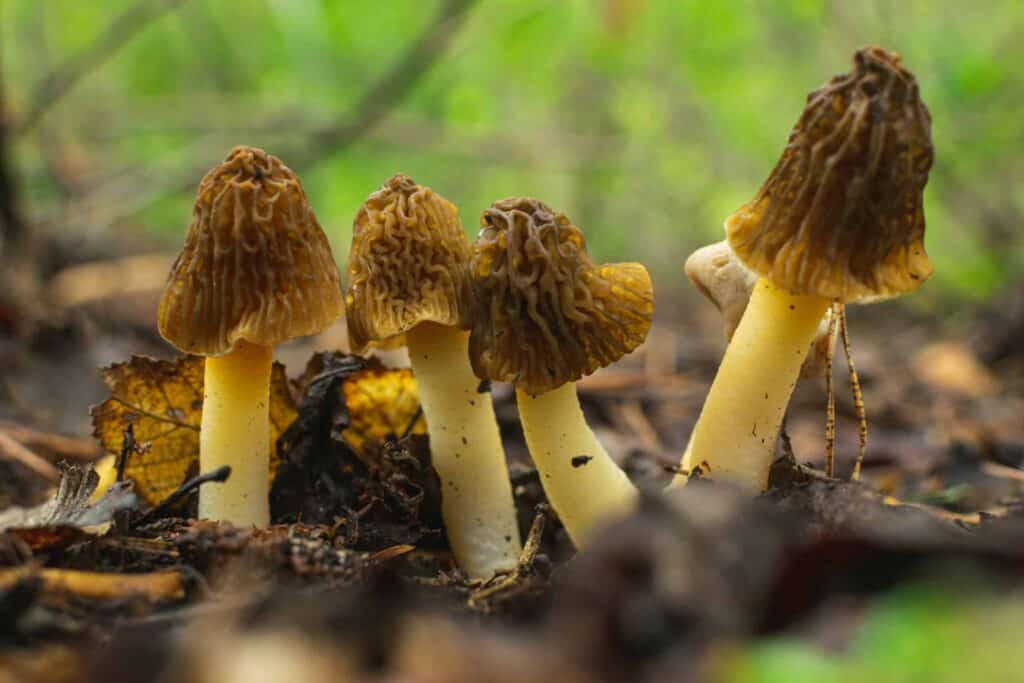
Although not truly a morel, this mushroom makes a similar showing with its distinctive brain-like shape and its brownish cap. When cooked, false morels have a nutty flavor that makes them a popular choice for soups, stews, and other dishes.
The best time to harvest them is just before they open up fully. When cleaning early false morels, it’s important to cut off the stems and wash them thoroughly. They can then be cooked in a variety of ways, including sauteed, grilled, or baked.
9. Black Chanterelle (Polyozellus multiplex)
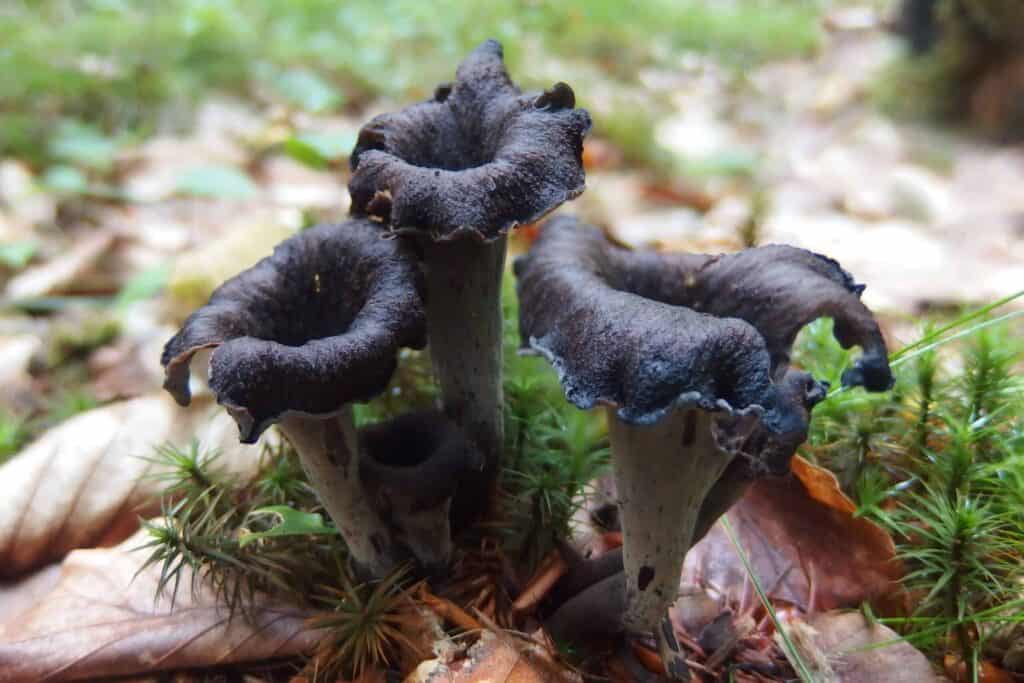
The black chanterelle is native to much of North America but is particularly at home in Alaska.
It gets its name from its deep black coloration, which is caused by the presence of melanin pigment in the cap. Black chanterelles are prized by chefs for their unique flavor, which has been described as earthy and slightly sweet.
When cooked, black chanterelles turn a dark brown color and have a soft, velvety texture. For this reason, they are often used as a garnish or added to dishes for flavor and visual appeal.
10. Bear’s Head (Hericium abietis)
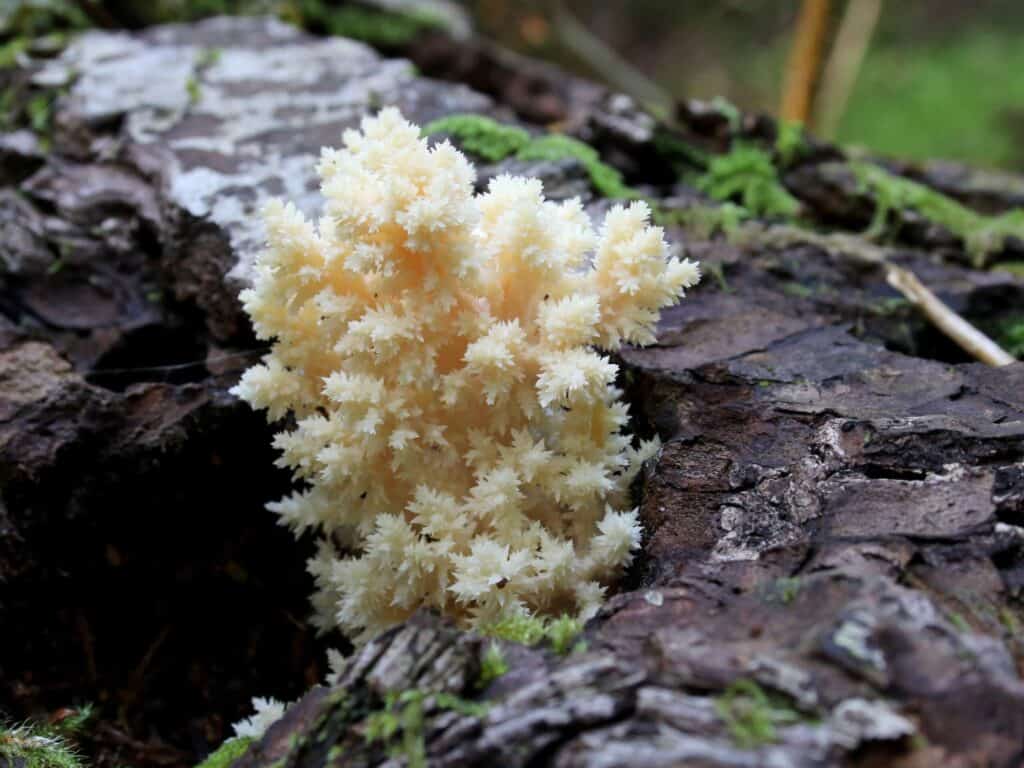
I’ll admit that the first time I found Bear’s head I was a bit reluctant to touch it, let alone eat it. It looks more like something that should live under the ocean (or on another planet) than the typical mushrooms I look for.
However, hungry foragers can’t be too picky and this one ended up being a great one to try.
Bear’s head mushrooms have a white or cream-colored cap with several small, spiky arms protruding from the center. The arms are covered in small, brown spores. Bear’s head mushrooms typically grow on dead or dying trees.
Some people say that they have a slightly sweet or even fishy taste, while others find them to be bland.
Bear’s head mushrooms are a relatively rare find in the wild, but they are becoming more popular with home cooks and professional chefs alike. They are also a good source of nutrients, including selenium, potassium, and Vitamin D.
11. Admirable Bolete (Boletus mirabilis)
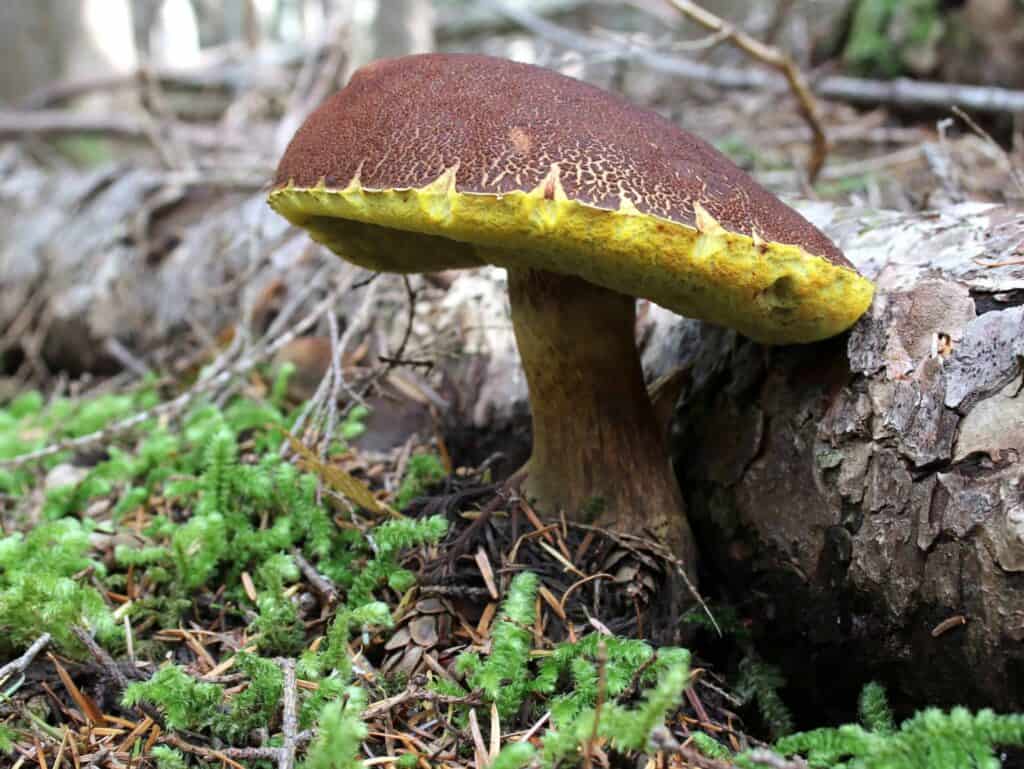
The Admirable Bolete gets its name from its unique appearance. The top of the mushroom is red, while the bottom is white (and I always thought that it looked like a fancy Admiral’s hat…).
The Admirable Bolete is a sausage-shaped mushroom with a short stalk. This mushroom can grow up to six inches tall and two inches wide. The flesh of the mushroom is often quite spongy but the flavor is mild with a hint of sweetness.
King Botele vs Admiral Botele
While most people have no trouble telling apart Kings and Admirals there are more differences than you might expect at first blush.
For one, the admirable bolete is typically smaller in size, with a cap that measures just 2-3 inches in diameter. The king bolete, on the other hand, can often grow to be twice as large, with a cap that can reach up to 6 inches in diameter. Additionally, the two mushrooms have different coloring – the Admirable bolete typically has a reddish-brown cap, while the king bolete often has a yellow or white cap.
Finally, the two mushrooms also have different tastes – the Admirable bolete is known for its earthy flavor, while the king bolete is often described as being more bitter.
12. Chicken of the Woods (Laetiporus sulphureus)
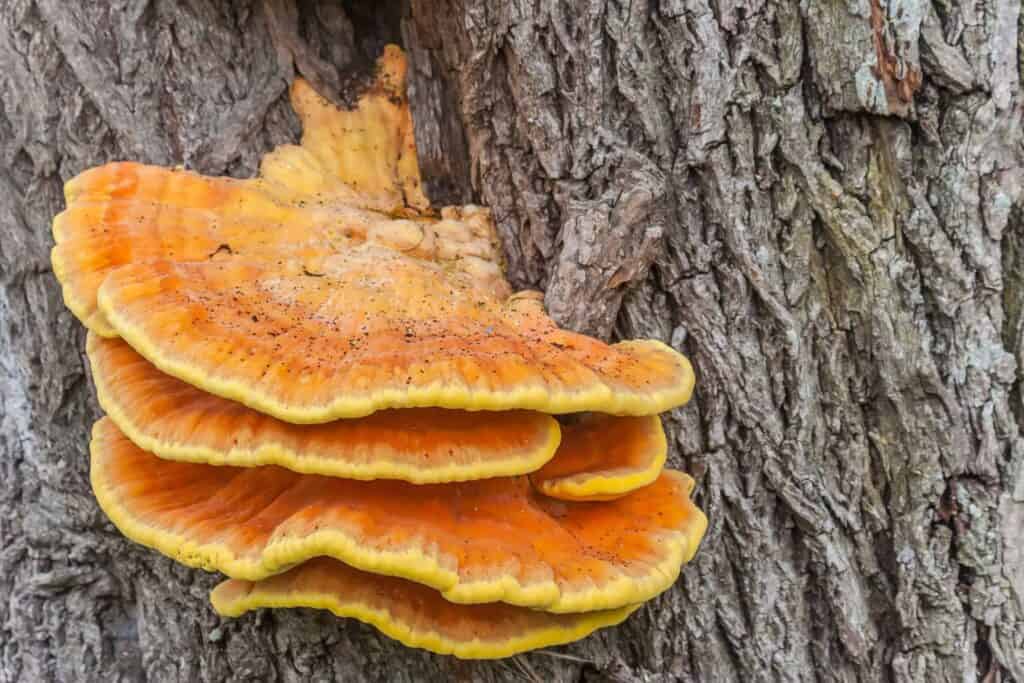
If you’re fortunate enough to find chicken of the woods (Laetiporus sulphureus) mushrooms in Alaska, consider yourself lucky – they’re not only deliciously edible, but they’re also high in nutrients! Also known as sulfur-shelf mushrooms, these delectable fungi get their name from their chicken-like flavor and appearance.
While they can be found throughout North America, they’re especially prevalent in the Pacific Northwest and Alaska. Chicken of the woods mushrooms are a great source of protein, vitamins, minerals, and antioxidants. They can be enjoyed cooked or raw although I would cook them.
Although sulfur mushrooms like Chicken of the Woods might not actually be a mushroom, it gets a place on this list as it is a fungus and is edible.
13. The Gypsy (Cortinarius caperatus)
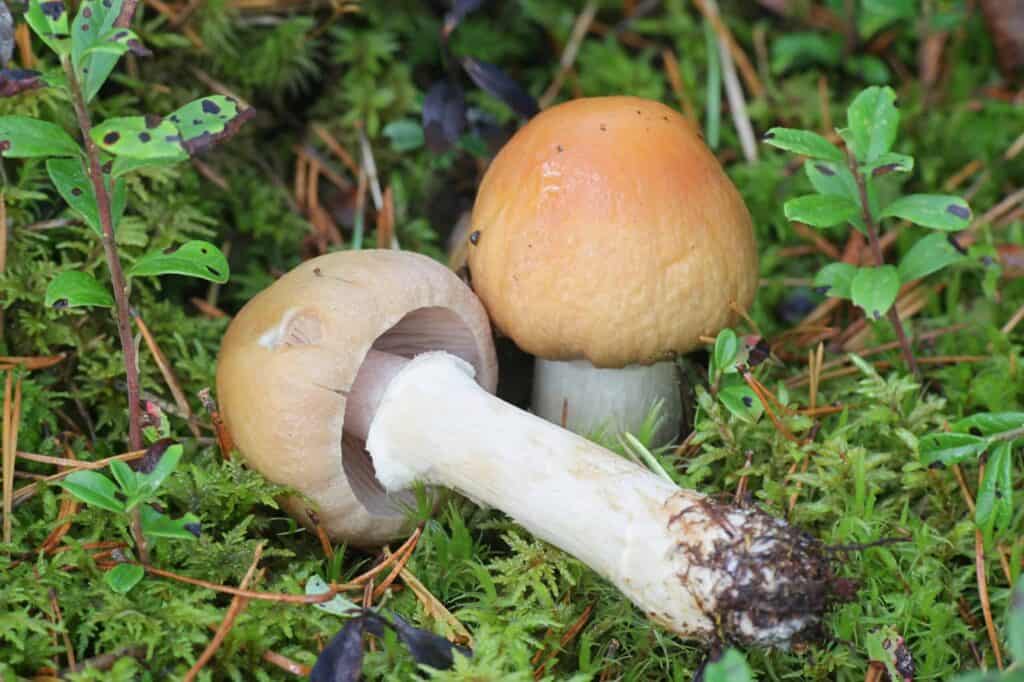
The gypsy mushroom is a type of Cortinarius mushroom that is native to North America, including Alaska.
It gets its name from its tendency to grow in large numbers, often “carpeting” the forest floor. The gypsy mushroom is edible and has a distinctive flavor that has been described as earthy, nutty, or even reminiscent of seafood.
While it is not the most popular type of mushroom, it is worth seeking out for any mushroom lovers looking to add something new to their repertoire. Like most mushrooms, the gypsy mushroom should be cooked before eating, as raw mushrooms can be poisonous.
So next time you’re out for a walk in the woods, keep an eye out for these little fungi – you might just find yourself a new favorite food (but honestly…probably not…)
3 Tips For Mushroom Foraging In Alaska
There’s nothing quite like a dish made with fresh, foraged mushrooms. However, if you go about it the wrong way you might never have the experience.
Some Alaskan foragers can fill a basket every time they go out while others struggle to find anything at all. So what’s the secret? What do experienced mushroom foragers know that the rest of us need to learn? Well, it’s three things:
Look for the Right Conditions
Mushrooms need specific conditions to thrive, so the first step in finding them is to know what those conditions are. In Alaska, this is highly dependent on the weather so you’ll want to learn the pattern of when mushrooms start fruiting.
Depending on the type of mushroom you’re looking for, you’ll also need to find the right kind of environment. For example, morel mushrooms tend to grow near dead or dying elm trees. On the other hand, Chanterelles can be found in damp forests near spruce and hemlock trees. Do some research on the type of mushroom you want to find, and then narrow your search to areas that fit those conditions.
Cover Lots Of Ground
If you’re in an area that is dry and not producing for you, move! Mushrooms tend to like specific places and, once you find a honey hole, you can keep going back. Until that point, you’ll face a lot of trial and error as you’ll likely start in disappointing spots.
Consult a Mushroom Identification Guide
For the love of all that is holy, use a field guide when you’re out foraging. If you’re still not sure whether a mushroom is safe to eat, your best bet is to consult a comprehensive guidebook. You can find these online or at your local library. Many of these guides will include pictures and detailed descriptions of different types of mushrooms, which can be helpful if you’re having trouble identifying one based on appearance alone. Once you’ve narrowed down the options, check the guidebook for any warnings about poisonous varieties that might resemble the mushroom in question.
Conclusion
Alaskan winters may be long and dark, but spring brings with it an abundance of edible mushrooms!
With a little knowledge and some careful searching, you can find chanterelles, morels, oyster mushrooms, porcinis, and penny buns growing all over the state. So grab your basket and your hiking boots, and happy foraging!

